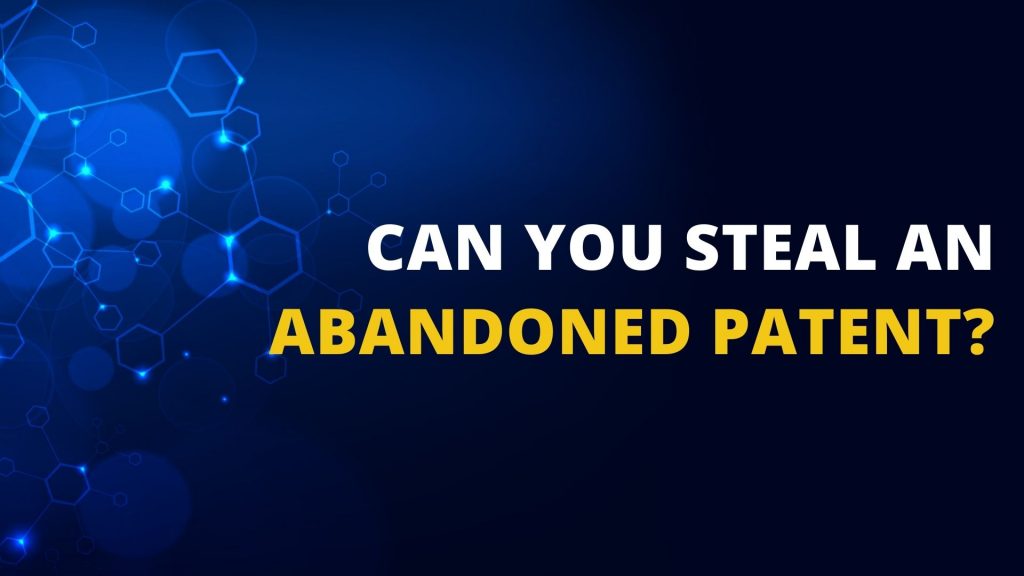Can you steal an abandoned patent? This is a question that has been asked by many business owners over the years. The answer to this question is not as simple as it may seem. In this blog post, we will explore what it means to steal an abandoned patent and discuss the pros and cons of doing so. We will also provide some tips on how you can protect yourself from being accused of patent theft.
What is an abandoned patent and how does it work?
An abandoned patent is a patent that was once owned by an inventor or company, but has since been discontinued and left unclaimed. Generally, an abandoned patent will have expired due to non-payment of renewal fees or abandonment of the invention for other reasons.
When it comes to reclaiming an abandoned patent, the process varies from country to country. In the US for example, an individual or company can request a certificate of correction from the US Patent and Trademark Office (USPTO), which allows them to take ownership of the patent and make any necessary changes.
What are the benefits of owning an abandoned patent?
Owning an abandoned patent can provide many benefits. Firstly, the patent owner has exclusive rights to prevent others from making, using or selling the patented product for a period of time. This allows the patent holder to capitalize on their invention and potentially reap financial gains from it. Furthermore, if someone else tries to copy your invention, you can take legal action against them for patent infringement.
Additionally, an abandoned patent can provide protection from competitors who are trying to market similar products. If your invention is patented and another entity creates a competing product, you may be able to sue them for infringing upon your patent rights. This can help protect the value of your innovation and ensure that consumers recognize your brand as the leader in its respective field.
Finally, owning an abandoned patent can provide a stepping stone for further innovation and development. With exclusive rights to the patent and associated innovations, you may be able to create new and improved versions of the patented invention. This way, your company can remain competitive in the marketplace and continue to develop marketable products.
How can you go about acquiring an abandoned patent?
When a patent holder fails to meet certain requirements, such as meeting the payment deadlines or maintaining their patent rights, the patent can become abandoned. If this happens, the patent is no longer legally enforceable and may be available to be claimed by another individual or company.
The process of acquiring an abandoned patent begins with researching potential patents that may be available. There are a number of sources you can use to find an abandoned patent, such as the United States Patent and Trademark Office (USPTO) or other patent search databases.
Once you have identified a potential patent to acquire, it is important that you verify that the patent has indeed been abandoned. This can be done by using the USPTO’s Public Pair system or a patent search specialist to determine if there are any unpaid maintenance fees or other issues that may have caused the patent to be abandoned.
Once you have verified that the patent is available, you will need to submit an application to acquire it. Depending on your country and jurisdiction, this process can vary and may require the assistance of a patent attorney or agent.
When submitting an application to acquire an abandoned patent, it is essential that you provide adequate evidence that the patent is indeed abandoned. This typically includes proof of unpaid maintenance fees, as well as correspondence from either the United States Patent and Trademark Office (USPTO) or the original patent holder indicating that the patent is abandoned.
Once your application is accepted, you will be required to pay a fee and agree to certain restrictions associated with using the patent. It is also important to note that once you have acquired an abandoned patent, you may still be subject to infringement suits if another party can prove they are the legitimate patent holders.
Although it is possible to acquire an abandoned patent, the process can be complicated and time-consuming. It is important to thoroughly research potential patents and contact a patent attorney or agent before attempting to acquire an abandoned patent. Doing so can help ensure that you are able to successfully claim an abandoned patent while avoiding any legal issues down the line.
What are the risks associated with owning an abandoned patent?
- Owning an abandoned patent can be a tricky endeavor and comes with certain risks.
- First, it is not always clear who actually owns the patent. If there is a dispute as to who the rightful owner of an abandoned patent is, this may lead to costly litigation if someone attempts to assert ownership rights.
- Additionally, there may be hidden costs associated with an abandoned patent.
- Although the patent may have been abandoned, any licensing agreements or contracts that are associated with it must still be honored and adhered to, which can lead to unforeseen costs for the new owner.
- Finally, if a patent has been abandoned for a long period of time, there is no guarantee that the rights granted by the patent are still valid. The patent may have been invalidated over time due to changes in technology or competing patents that were filed afterward.
Therefore, it is important for anyone considering taking ownership of an abandoned patent to research the current validity of the patent carefully before doing so. By understanding and weighing these risks, you can make a more informed decision about whether or not an abandoned patent is worth the effort. Ultimately, it can be a great way to acquire valuable intellectual property rights, but risks should be assessed carefully first.
How do you know if a patent is abandoned or not?
Knowing whether a patent is still in force or not is essential to deciding if it can be used. Generally, patents become abandoned when the holder fails to pay the required fees or fulfill other obligations. In some cases, an inventor may also decide to abandon their patent intentionally.
A quick way to see if a patent has been abandoned is to search for it in the USPTO database. Usually, a statement about abandonment will be included in the patent record if the application has been withdrawn or expired.
In some cases, patents can also become abandoned due to latches caused by market activity or external factors such as litigation or delays in prosecution. This means that even when there’s no official record of abandonment, a patent may still be legally available for use.
If you believe that a patent has been abandoned or is otherwise unenforceable due to such laches, it’s best to research and contact the original inventor before attempting to use the patent. This is important because failing to do so can result in legal issues.
If the inventor confirms that they do not intend to pursue their patent, then it is likely considered abandoned and you can attempt to use it. However, doing so without permission or proper documentation may still present a risk of infringement suits, so it’s important to proceed with caution.
In the end, the best way to know if a patent is abandoned or not is to thoroughly research it and contact the original inventor before attempting to use it. Doing so can help you avoid legal problems that may arise from using an abandoned patent without permission.







